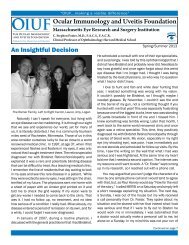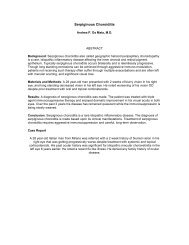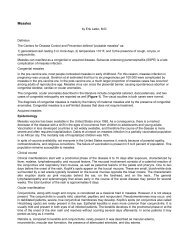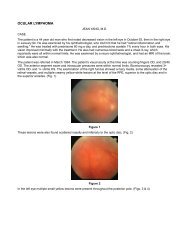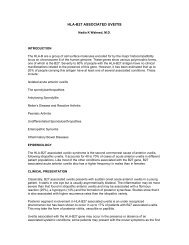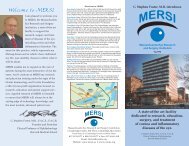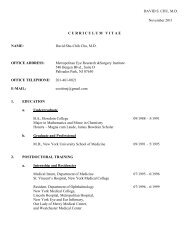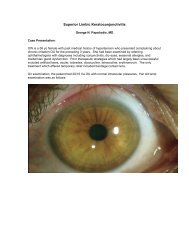cogans_syndrome.pdf (155.28 KB) - Ocular Immunology and Uveitis ...
cogans_syndrome.pdf (155.28 KB) - Ocular Immunology and Uveitis ...
cogans_syndrome.pdf (155.28 KB) - Ocular Immunology and Uveitis ...
You also want an ePaper? Increase the reach of your titles
YUMPU automatically turns print PDFs into web optimized ePapers that Google loves.
COGAN'S SYNDROMEByElisabetta Miserocchi, MDCLINICAL CASEPatient: A 28 year old man, Caucasian.Chief complain 3/2000:Redness <strong>and</strong> light sensitivity in both eyes.Past ocular history:Two year history of bilateral keratitis treated with topical steroids with initial improvement <strong>and</strong> subsequently becomeunresponsive.Past medical history:Idiopathic hearing loss since 1996, unresponsive to systemic cyclophosphamide <strong>and</strong> high doses of prednisone.Review of systems:- Headache: constant <strong>and</strong> in the frontal region, poorly responsive to conventional pain medications.- Back pain <strong>and</strong> arthralgia.- Subcutaneous nodules, rash on the volar part of the left arm.Figure 1: skin nodules <strong>and</strong> rashPrevious work-up:- Chest X-ray: possible left hilar adenopathy.- Chest CT scan: normal.- FTA-Abs, Lyme test, ACE, ESR: all normals.Examination:Visual acuity: OD=20/30 PH OS=20/20 PHSlit-lamp: corneal neovascularization <strong>and</strong> abundant lipid deposition in the stroma in the superior half of bothcorneas.Figure 2: corneal neovascularization in OD(left) <strong>and</strong> in OS(right)Corneal sensation: normal.IOP: normal.Ophthalmoscopy: unremarkable.Assessment:
- Bilateral sectoral keratitis.- Bilateral hearing loss.- Systemic associated symptomatology.Plan:- Otolaringologist consult because of the association of ear <strong>and</strong> ocular manifestations.- Additional serology to exclude any type of vasculitis (mainly PAN <strong>and</strong> Wegener's) because of the peripherallocation of the keratitis (PUK like) <strong>and</strong> also to assess the systemic involvement through markers of immune systemactivity <strong>and</strong> systemic inflammation.- Neurologic consult because of the persistent headache in order to exclude possibility of CNS involvement.Results of investigations:- Audiogram: sensorineural deafness, cochlear pathology pattern.- Antibodies against inner ear (HSP 70) detected with Western blot.- Elevated serological parameters: ESR, CRP, alpha-1 acid glycoprotein, eosinophil count.- MRI of the brain: normal.Diagnosis:Definite diagnosis of Cogan's <strong>syndrome</strong> was made.Follow up 4/2000:- Decreased vision <strong>and</strong> increased astigmatism in OD: VA OD=20/400- Penetrating keratoplasty performed on 6/2000.
- Visual acuity at one month follow-up: VA OD=20/40- Audiogram stable with daily dose of 40 mg prednisone.Teaching points of the case:- Atypical case of Cogan's <strong>syndrome</strong> because of the extreme delay (3 years) between ear <strong>and</strong> ocularmanifestations <strong>and</strong> the lack of interstitial keratitis at the time of ear involvement.- Unusual corneal neovascularization in both eyes resulting in visual impairment <strong>and</strong> requiring penetratingkeratoplasty.- Presence of serological markers indicative of systemic involvement: patient need to be carefully monitored forpresence of complications secondary to systemic vasculitis.COGAN'S SYNDROMEDavid Cogan first described in 1945 a <strong>syndrome</strong> characterized by non syphilitic interstitial keratitis associated withvertigo, tinnitus <strong>and</strong> profound deafness.Since then, approximately 150 cases with ocular inflammation <strong>and</strong> vestibuloauditory symptoms have beendescribed in the literature.EpidemiologyCogan's <strong>syndrome</strong> is a rare disease, <strong>and</strong> affects predominantly young adults. The average age of disease onset is29 years (range 3 to 50 years). In most of the literature series there seems to be no sexual predilection. In 25% ofpatients the eye <strong>and</strong> the ear can be affected simultaneously <strong>and</strong> in another 10% of the cases systemic vasculitiscan complicate the course of the disease. The clinical spectrum of patients with Cogan's <strong>syndrome</strong> includes ocularmanifestations, vestibuloauditory symptoms <strong>and</strong> systemic features.<strong>Ocular</strong> featuresPatients with typical Cogan's <strong>syndrome</strong> present with interstitial keratitis (72%) <strong>and</strong> M‚niÏre's-like audiovestibulatorydysfunction with acute onset of nausea, vomiting, tinnitus <strong>and</strong> vertigo, rapidly followed by bilateral hearing loss.Conversely, atypical manifestations of Cogan's <strong>syndrome</strong> include scleritis (anterior <strong>and</strong> posterior), episcleritis(20%), iritis (32%), conjunctivitis,vitritis, pars planitis, retinal vasculitis, retinal hemorrhages, choroiditis, papillitis,orbital pseudotumor, <strong>and</strong> tenonitis. The audiovestibulary symptoms can precede or follow the ocular manifestations,but usually the length of time between the ear <strong>and</strong> ocular involvement ranges from 2 to 52 weeks; when theaudiovestibulary dysfunction is different from the M‚niÏre's disease or occurs more than two years after ocularabnormalities, the patient is considered to have atypical Cogan's disease.The interstitial keratitis was originally described by Cogan's as a granular type of corneal infiltrate, with patchydistribution, situated predominantly in the posterior half of the cornea. The most common early corneal findings arefaint peripheral, anterior stromal subepithelial infiltrates measuring approximately 0.5 to 1 mm in diameter,mimicking adenovirus <strong>and</strong> chlamydial keratitis <strong>and</strong> disappearing promptly with institution of topical corticosteroids.Faint subepithelial scars or epithelial erosions may overlie the stromal infiltrates after resolution of the cornealinflammation. Since the disease can have a capricious course characterized by intermittent episodes of ocularinflammation alternated by periods of quiescence, <strong>and</strong> the ocular findings can be evanescent, repetitiveexaminations may be necessary to demonstrate evidence of ocular inflammation, particularly interstitial keratitis.
Papillitis in a case of atypical Cogan'sChorioretinal folds in atypical Cogan'sProgression to late corneal neovascularization causing visual impairment <strong>and</strong> requiring penetrating keratoplasty israre <strong>and</strong> occurs in less than 5% of patients.TYPICAL COGAN'S DISEASEInterstitial keratitisMeniere’s symptomsInterval between eye <strong>and</strong> ear < 2 yearsATYPICAL COGAN'S DISEASEScleritis, episcleritis, conjunctivitisIridocyclitisVitritisRetinal vasculitis, hemorrhages, cotton-wool spots, choroiditisOrbital pseudotumor, exophthalmos, tenonitisEar findingsPatients frequently present with sudden onset of Meniere’s like symptoms such as nausea, vomiting, tinnitus,fluctuations of hearing <strong>and</strong> severe vertigo.
The auditory involvement may be unilateral initially, but bilateral hearing loss usually follows. Vestibular systemdysfunction can also produce severe nystagmus, oscilloscopia <strong>and</strong> ataxia. In the majority of patients (92%)Meniere’s symptoms are associated with hearing loss. Untreated, deafness become complete in weeks to months,while vestibular symptoms usually improve <strong>and</strong> disappear after a few years from disease onset.The audiogram test is abnormal in 95% of patients with Cogan's <strong>syndrome</strong>; the hearing loss is more pronounced atthe extreme frequencies, with relatively sparing of the mid range, with a pattern usually seen in patients withMeniere’s <strong>syndrome</strong> indicating cochlear pathology.Auditory evoked potentials are also reduced or absent <strong>and</strong> suggestive of sensorineural deafness <strong>and</strong> the calorictest is also absent in 70% of patients.Systemic featuresIn association with the eye <strong>and</strong> the ear involvement non specific systemic symptoms can occur such as fever,fatigue, headache, arthralgia, myalgia <strong>and</strong> weight of loss.Some of the systemic symptoms may be secondary to systemic necrotizing vasculitis, which is present in 10 to50% of patients with Cogan's <strong>syndrome</strong>.The vasculitis affects large- vessels (Takayasu-like) <strong>and</strong> medium-vessels (polyarteritis nodosa-like). Systemicnecrotizing vasculitis has been in described in different vessels such as coronary, gastrointestinal tract, subclavian,femoral, renal, skin, testicle <strong>and</strong> muscle.The most serious manifestation of the vasculitis is cardiovascular involvement <strong>and</strong> patients often have silentcoronary artery disease. Inflammatory aortitis leading to aortic insufficiency is one of the most frequent problems,affecting about 10 % of cases. Patients can be asymptomatic or have associated cardiac abnormalities rangingfrom valvular defects, coronary disease, aneurysm, myocardial infarction, coronary arteritis, pericarditis, <strong>and</strong>arrhythmias.The aortitis may develop within weeks to years after the onset of Cogan's <strong>syndrome</strong>.Other symptoms indicative of systemic vasculitis include abdominal pain, lower extremity claudication, symptoms ofmesenteric insufficiency, proteinuria or microscopic hematuria due to renal involvement. The diagnosis of systemicnecrotizing vasculitis is made with angiography or biopsy.Ten percent of patients have fatal or nearly fatal complications secondary to systemic vasculitis, especially patientswho are asymptomatic. Echocardiographic <strong>and</strong> doppler abnormalities have been described in patients withasymptomatic aortic insufficiency.The possibility of systemic vasculitis with prompt recognition of signs <strong>and</strong> symptoms of organ involvement <strong>and</strong>further appropriate investigations must be considered at any stage of Cogan's disease, <strong>and</strong> institution of systemicimmunosuppression is m<strong>and</strong>atory in such cases.Similarities with polyarteritis nodosa have been noted in the histopathologic features of the affected vesselsconsisting of prominent infiltration of large veins <strong>and</strong> muscular artery walls with lymphocytes <strong>and</strong> neutrophils; focaldegeneration <strong>and</strong> varying degrees of fibrosis in the vessel walls have also been described.Systemic symptoms in Cogan's <strong>syndrome</strong>Organ involvementNervous systemSymptoms <strong>and</strong> signsHeadache, meningismus, encephalitis, psychosis, cerebralinfarction, cavernous sinus thrombosis, psychosis, peripheralnerve involvementMusculoskeletalArthralgia, arthritis, myalgiaGastrointestinalAbdominal pain, gastric hemorrhageCardiacAortic insufficiency, arrhythmias, ventricular hypertrophy, valvulardefectsSkinNodules, non-specific rash, palpable purpura,GenitourinaryAbnormal urinalysis, hematuria, proteinuria, testicular painPulmonaryPleuritis, pulmonary nodules,
LymphoreticularLymphoadenopathy, splenomegaly, hepatomegalyDiagnosisThe diagnosis of Cogan's <strong>syndrome</strong> is established by the clinical observation of ocular <strong>and</strong> audiovestibularabnormalities. When the symptoms are not present concomitantly or when the patient presents with atypical ocularfindings, the diagnosis as well as prompt institution of corticosteroid treatment may be delayed, causing severe <strong>and</strong>irreversible hearing loss.Antibodies against the inner ear <strong>and</strong> cornea may support the clinical suspicion, but they are not specific for Cogan's<strong>syndrome</strong> because they present also in other idiopathic bilateral vestibulopathies.Laboratory abnormalities usually associated with the <strong>syndrome</strong> are eosinophilia, anemia, thrombocytosis, elevatederythrocyte sedimentation rate. Low titers of rheumatoid factor, antinuclear antibodies <strong>and</strong> cryoglobulins areobserved in 15% of patients.An increased frequency of HLA-B17 <strong>and</strong> HLA-A9 has been reported, but the significance of these studies is notclear.Cerebrospinal fluid abnormalities including leukocytosis, elevated protein <strong>and</strong> increased gamma globulin fractionare seen in 25% of patients.The clinical diagnostic tests in patients with Cogan's <strong>syndrome</strong> should include: audiogram, caloric test,echocardiography, doppler test, <strong>and</strong> angiography when systemic vasculitis is suspected. The multisystemic aspectof the <strong>syndrome</strong> emphasize for the need for coordination between ophthalmologist, otolaryngologist <strong>and</strong> internist.DifferentialDiagnosisWhen interstitial keratitis is present other causes for corneal inflammation such syphilis, sarcoidosis, tuberculosis,viral conditions (HSV, VZV), Lyme disease <strong>and</strong> leprosy must be excluded.A wide spectrum of infectious <strong>and</strong> rheumatologic conditions which cause ocular inflammation associated withaudiovestibulatory symptoms <strong>and</strong> hearing loss may also be considered in the differential diagnosis.Causes of eye <strong>and</strong> ear involvement.InfectiousSyphilis (congenital > acquired), Lyme, Viral,Chlamydia, Tuberculosis with streptomycinAutoimmunePolyarteritis nodosa, Wegener'sgranulomatosis, giant cell arteritis, Takayasuarteritis, relapsing polychondritis, rheumatoidarthritis, BehÇet's, Vogt-Koyanagy-Harada,sarcoidosis, Meniere with ocular inflammationOthersCobalt, desferioxaminePathogenesisThe pathogenesis of Cogan's <strong>syndrome</strong> is unknown; an autoimmune mechanism has long been postulated but ithas remained unclear whether this process is mediated by cellular or humoral immunity.Some pathological <strong>and</strong> immunological findings such as lymphocytes, <strong>and</strong> plasma cell infiltration in the cochlea <strong>and</strong>in the cornea, presence of antibodies (IgG) against inner ear <strong>and</strong> cornea, as well as the beneficial effect ofcorticosteroids <strong>and</strong> immunosupressants all support an autoimmune pathogenesis. Moreover, most of the patientsexhibit variable, multiple organ involvement reminiscent of polyarteritis nodosa <strong>and</strong> other collagen diseases withpresumed autoimmune etiology.
Histopathologic section of the corneaThe evidence of immediately preceding upper respiratory tract infection in 40% of patients <strong>and</strong> elevated antibodytiters against chlamydia has lead some authors to hypothesize that Cogan's <strong>syndrome</strong> is an autoimmune diseasemediated by hypersensitivity response to one or more infectious agents.Pathogenesis of deafnessTemporal bone pathology has shown different findings responsible for deafness including endolymphatic hydrops,atrophy of the organ of Corti, plasma cell <strong>and</strong> lymphocytic infiltration of the spiral ligament, osteogenesis of theround window, spiral ganglion cell degeneration, degeneration of the stria vascularis, demyelinization of the eightcranial nerve <strong>and</strong> vasculitis of the internal auditory artery.TreatmentTherapy of Cogan's <strong>syndrome</strong>,when ear involvement is detected, consists of high doses systemic corticosteroids(1-2 mg/ Kg/day) which are subsequently slowly tapered based upon the responses on the audiogram test. Whensystemic corticosteroids are given early during the course of the disease, the outcome varies from partial recoveryof the hearing loss to absence of response <strong>and</strong> profound deafness.Some reports indicate that the hearing loss may be reversible if the diagnosis is made within the first two weeks<strong>and</strong> high doses of corticosteroids therapy is initiated promptly.Systemic immunosuppression is m<strong>and</strong>atory in patients with necrotizing vasculitis; cyclophosphamide is the drug ofchoice, but azathioprine, methotrexate <strong>and</strong> cyclosporin have also been reported to be effective.In cases of hearing loss unresponsive to corticosteroid treatment, immunosuppressant agents may be used <strong>and</strong>better responses are usually obtained when a chronic low dose of steroid is maintained.The ocular manifestations typically respond to topical steroids <strong>and</strong> systemic treatment is reserved to patients withposterior involvement (retinal vasculitis, posterior uveitis).PrognosisThe ocular prognosis in patients with interstitial keratitis is usually very good <strong>and</strong> only rare cases have visual acuityimpairment secondary to corneal opacity. More severe complications can occur in patients with atypical disease<strong>and</strong> chronic inflammation of the posterior pole.Differently from the eye involvement, the ear prognosis is poor. Total <strong>and</strong> bilateral deafness is the predominantoutcome in Cogan's <strong>syndrome</strong>, occurring in 25 to 50% of patients, even when corticosteroids are promptlyadministered; 95% of patients have moderate to profound hearing loss at five-years follow up. Vestibular symptoms<strong>and</strong> signs improve with time, but persistent ataxia <strong>and</strong> oscilloscopia have been reported in 15% of cases.Systemic involvement is associated with 10% of fatal complications secondary mainly to aortic, coronary,mesenteric <strong>and</strong> renal vasculitis.ConclusionsCogan's <strong>syndrome</strong> is a systemic disease that typically presents with interstitial keratitis <strong>and</strong> audiovestibulatorysymptoms. The presence of systemic vasculitis <strong>and</strong> potential fatal complications give reason for considering thisdisorder not only an "eye <strong>and</strong> ear problem". In some cases the atypical ocular manifestation <strong>and</strong> the lack ofassociated ear findings make the diagnosis more difficult <strong>and</strong> cause delay in institution of adequate treatmentresulting in profound bilateral deafness.References1. Cogan DG. Syndrome of non syphilitic interstitial keratitis <strong>and</strong> vestibuloauditory symptoms. Arch Ophthalmol1945; 33: 144-49.2. Vollertsen RS et al. Cogan's <strong>syndrome</strong>: 18 cases <strong>and</strong> a review of the literature. Mayo Clin Proc 1986; 61: 344-61.
3. Morgan GJ et al. Cogan's <strong>syndrome</strong>: acute vestibular <strong>and</strong> auditory dysfunction with interstitial keratitis. Am JOtolaryngol 1984; 5: 258-61.4. Garcia Berrocal JR et al. Cogan's <strong>syndrome</strong>: an oculo-audiovestibular disease. Postgrad Med 1999; 75: 262-64.5. Vollertsen RS et al. Cogan's <strong>syndrome</strong>: audiovestibular involvement <strong>and</strong> prognosis in 18 patients. Laryngoscope1985; 95: 650-54.6. Schuknecht HF et al. Temporal bone pathology in a case of Cogan's <strong>syndrome</strong>. Laryngoscope 1994; 104: 1135-42.7. Allen NB et al. Use of immunosuppressive agents in the treatment of severe ocular <strong>and</strong> vascular manifestationsof Cogan's <strong>syndrome</strong>. Am J Med 1990; 88: 296-301.8. Ho AC et al. Cogan's <strong>syndrome</strong> with refractory abdominal aortitis <strong>and</strong> mesenteric vasculitis. J Rheumatol 1999;26: 1404-07.9. Helmchen C et al. Cogan's <strong>syndrome</strong>: clinical significance of antibodies against the inner ear <strong>and</strong> cornea. ActaOtolaryngol 1999; 119: 528-36.10. Heinemann MH et al. Cogan's <strong>syndrome</strong>. AnnOphthalmol 1980; june: 667-74.11. Cogan DG et al. Late corneal opacities in the <strong>syndrome</strong> of interstitial keratitis <strong>and</strong> vestibulo-auditory symptoms.Acta Ophthalmol 1989; 67: 182-87.12. Cheson BD et al. Cogan's <strong>syndrome</strong>: a systemic vasculitis. Am J Med 1976; 60: 549-55.13. Majoor MHJM et al. Corneal autoimmunity in Cogan's <strong>syndrome</strong>? Report of two cases. Ann Otol Laryngol 1992;101: 679-84.14. Del Carpio J et al. Cogan's <strong>syndrome</strong> <strong>and</strong> HLA-BW17. Letter to the editor. N Engl J Med 1976; 25: 1262-63.15. Hughes GB et al. Autoimmune reactivity in Cogan's <strong>syndrome</strong>: a preliminary report. Otol Head <strong>and</strong> Neck Surg1983; 91: 24-32.16. Eisenstein B et al. Non syphilitic interstitial keratitis <strong>and</strong> bilateral deafness (Cogan's <strong>syndrome</strong>) associated withcardiovascular disease. N Engl J Med 1958; 258 (22): 1074-79.17. Cogan DG et al. Nonsyphilitic interstitial keratitis with vestibuloauditory symptoms: a case with fatal aortitis.Arch Ophthalmol 1964; 71: 172-75.18. Cobo LM et al. Early corneal findings in Cogan's <strong>syndrome</strong>. Ophthalmology 1984; 91: 903-07.19. Gilbert WS et al. Cogan's <strong>syndrome</strong>: signs of periarteritis nodosa <strong>and</strong> cerebral venous sinus thrombosis. ArchOphthalmol 1969; 82: 633-36.



